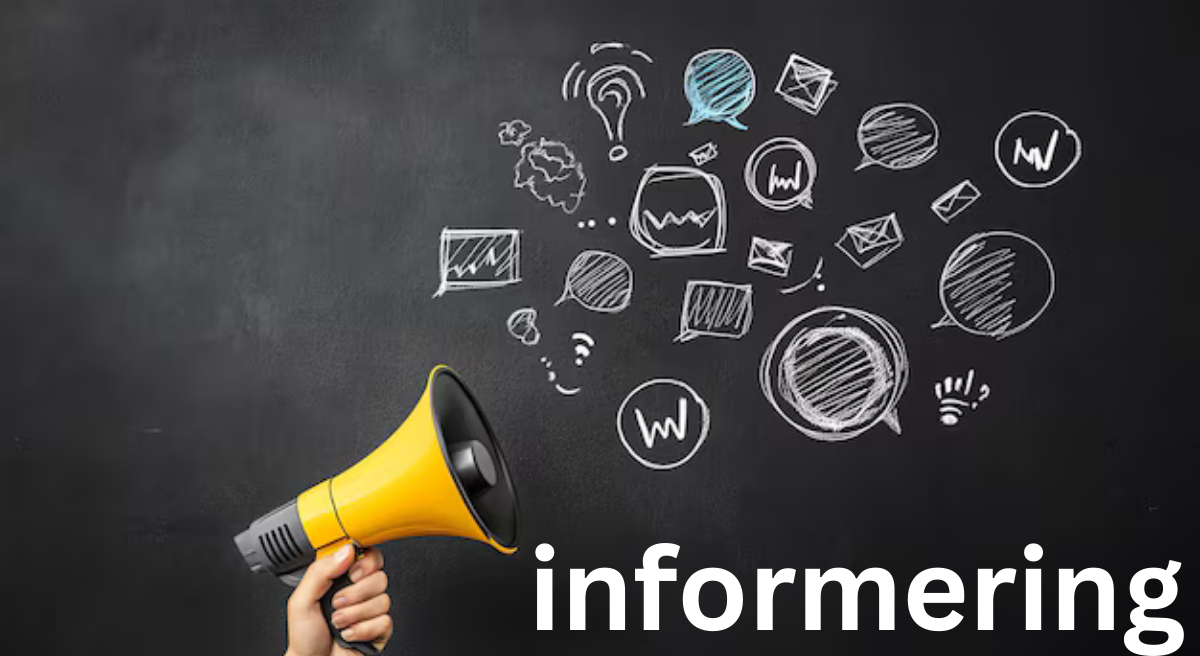TECHNOLOGY
Informing: A Detailed Overview

Informing is the act of sharing knowledge, data, or facts with others to increase awareness or understanding. This process is crucial in education, business, governance, and everyday interactions, as it ensures clarity and enhances decision-making. This article explores the meaning, importance, forms, and challenges associated with informing.
1. What is Informing?
Informing refers to the act of conveying information with the intent to educate, update, or alert others. It can occur in various forms, such as verbal communication, written texts, visual aids, or digital media. The goal is to transmit knowledge effectively, enabling recipients to act or respond appropriately.
2. The Importance of Informing
Clear and timely informing is essential across multiple domains, including:
- Education: Teachers inform students to develop skills and knowledge.
- Healthcare: Doctors inform patients about diagnoses and treatments.
- Business: Companies inform employees and customers about policies or new products.
- Public Sector: Governments inform citizens about laws, safety protocols, or public initiatives.
Well-informed individuals make better decisions, engage more actively, and avoid misinformation.
3. Forms of Informing
- Verbal Communication: Conversations, lectures, and meetings.
- Written Communication: Memos, emails, newspapers, and reports.
- Visual Communication: Charts, infographics, and diagrams.
- Digital Platforms: Websites, social media, and email newsletters.
Each form has its advantages and best-use scenarios depending on the audience and context.
4. Effective Informing Strategies
To ensure the information is correctly understood and utilized, some key strategies include: informering
- Clarity and Precision: Use simple language and avoid jargon.
- Relevance: Share only the information necessary for the audience.
- Timing: Provide information at the right time to maximize impact.
- Feedback Mechanism: Encourage questions or discussions to verify understanding.
5. Challenges in Informing
Despite its importance, several challenges may arise :informering
- Information Overload: Too much information can overwhelm the audience.
- Misinformation and Disinformation: False information can spread quickly and cause harm.
- Communication Barriers: Cultural, linguistic, or technological barriers can hinder effective communication.
- Lack of Attention: In today’s fast-paced world, maintaining audience engagement can be difficult.
6. The Role of Technology in Informing
Modern technology has revolutionized the way information is shared. Social media, websites, and instant messaging allow information to travel faster and reach wider audiences. However, the rapid dissemination also makes it easier for misinformation to spread, highlighting the need for media literacy.
7. Conclusion of informering
Informing is a fundamental process in society, ensuring people have the knowledge they need to make informed decisions. It requires clarity, relevance, and adaptability to meet the audience’s needs. With the rise of digital communication, effective informing also demands a careful balance to avoid misinformation and information overload.
TECHNOLOGY
Unveiling baddiehud: The Ultimate Tool for Gamers and Streamers

Gaming and streaming are no longer just hobbies—they are dynamic industries where individuality and creativity reign supreme. Whether you’re competing in the latest online multiplayer or streaming your gameplay to an audience of thousands, having the right tools can set you apart. Enter baddiehud, the groundbreaking platform designed to take your gaming and streaming experience to the next level.
With baddiehud, gamers and streamers can harness a suite of powerful tools to express their unique style, enhance their gameplay, and captivate their audience. Today, we’re breaking down everything you need to know about this cutting-edge platform and why it’s a must-have for the modern gaming enthusiast.
What Is baddiehud?
At its core, baddiehud is a customizable overlay toolkit that brings style and functionality to your gaming and streaming setup. Think of it as the ultimate user interface (UI) designed to help you stand out while maintaining peak performance.
Unlike standard overlays that may look generic or limit your creative options, baddiehud offers full customization. Add slick animations, manage performance data, personalize visuals, and much more—all without compromising your in-game experience. It’s the tool every dedicated gamer and content creator didn’t know they needed until now.
Why Gamers and Streamers Need baddiehud
Gaming and streaming are about more than just technical skills. They’re about engaging experiences, interactive storytelling, and unforgettable branding moments. Here’s why baddiehud is steadily becoming the go-to choice for both casual gamers and professional streamers:
1. Streamlined Overlay Customization
With baddiehud, your overlay is entirely in your hands. Create a HUD (Heads-Up Display) that matches your personal aesthetic while ensuring important data—like kills, scores, and stream analytics—stays front and center.
Whether you’re aiming for a minimalist vibe or a dazzling, eye-catching design, baddiehud empowers you to craft the perfect look to reflect your gaming identity.
2. Boost Audience Engagement
Streamers know that their audience is more than just spectators—they’re an active part of the experience. baddiehud includes tools to incorporate interactive overlays, such as chat visuals, donation alerts, and follower animations, all seamlessly integrated into your gameplay footage.
This doesn’t just keep your audience engaged—it makes them feel like part of your community, which builds loyalty and encourages repeat visits.
3. Performance Tracking Made Easy
Serious gamers need serious stats. baddiehud features a comprehensive performance tracking system, allowing you to monitor your FPS (frames per second), ping, CPU usage, and more in real time—all presented in a sleek, non-intrusive format.
Performance tracking helps you identify potential issues that could hinder your gameplay while keeping you ahead of the competition.
4. Brand Personalization for Streamers
If you’re a streamer competing in an increasingly crowded space, standing out is essential. With baddiehud, not only can you enhance your stream’s visuals, but you also have access to branding tools that keep your stream consistent and memorable. From custom color schemes to on-brand animations, complete control is at your fingertips.
5. User-Friendly Interface
What good is a revolutionary tool if it’s too complicated to use? baddiehud’s intuitive design ensures that even those new to creating overlays can get started quickly.
The platform offers drag-and-drop functionality, easy-to-follow tutorials, and pre-built templates that save you time while showcasing your individuality.
How baddiehud Transforms Gaming and Streaming
Now that we’ve covered the “what” and “why,” let’s dig into the “how.” Here’s a closer look at the key features that make baddiehud a game-changer:
Customizable Overlays
Choose from professionally designed templates or start from scratch to create overlays tailored to your preferences. Adjust widget placement, font styles, animations, and color schemes to craft an interface that feels uniquely yours.
Interactive Streaming Elements
Make your stream come alive with real-time alerts, dynamic chat windows, and visually stunning reactions every time you gain a new follower, subscriber, or donation.
Real-Time Performance Analytics
Maintain your competitive edge with a built-in performance dashboard. Monitor your system and network stats without leaving your game or disrupting your stream—because every millisecond matters.
Cross-Platform Compatibility
Whether you’re on Twitch, YouTube Gaming, or Facebook Gaming, baddiehud integrates seamlessly with all major streaming platforms. Gamers using PCs, consoles, or other setups will find baddiehud equally accommodating.
Regular Updates and Expansions
Gaming and tech evolve quickly, and so does baddiehud. Regular updates ensure you’ll always have the latest features and compatibility with new games.
Why baddiehud is the Future of Gaming Tools
Gaming and streaming continue to redefine the boundaries of what’s possible in entertainment and technology. The global video game forecast predicts the industry will generate $200 billion annually by 2024, underscoring its massive influence and growth potential.
To maximize your opportunities, you need tools that enable you to adapt, innovate, and stay ahead. baddiehud isn’t just another convenience—it’s a necessity for any gamer or streamer looking to level up their game and make a lasting impression.
The ability to customize, engage, and perform underpinned by an accessible and reliable platform makes baddiehud more than a product—it’s a solution that caters to all your creative and competitive needs.
How to Get Started with baddiehud
Excited to experience what baddiehud has to offer? Getting started is simple:
- Sign Up for Free
Head to [Insert Link] and create a baddiehud account—it’s free to get started!
- Explore Templates or Build from Scratch
Start with one of our sleek templates or bring your vision to life with our beginner-friendly editor.
- Integrate and Game On
Easily connect baddiehud to your favorite streaming platform and games. Hit ‘Start,’ and watch your audience grow while your style shines.
Elevate Your Setup Today
Whether you’re playing for fun, competing at a high level, or streaming for a global audience, baddiehud gives you the tools to succeed. From custom overlays to interactive alerts and unparalleled performance tracking, the possibilities are endless.
Take the first step in transforming your gaming and streaming experience—[Sign up for baddiehud today](Insert Link).
Conclusion
Level up your gaming and streaming potential with baddiehud—a platform designed to empower your creativity, enhance your performance, and captivate your audience. With its intuitive tools, seamless integrations, and unmatched customization options, achieving your goals has never been easier. Don’t just play—make an impact. Start your baddiehuds journey today and see the difference for yourself.
FAQ’s
What is baddiehud?
baddiehud is an all-in-one platform designed for gamers and streamers to elevate their content. It offers custom overlays, interactive alerts, and performance tracking tools to help you engage your audience and improve your streaming experience.
Is baddiehud beginner-friendly?
Absolutely! baddiehud is designed with ease of use in mind. Its intuitive interface ensures that users of all skill levels, from beginners to seasoned professionals, can create customized and impactful streams with minimal effort.
Do I need special hardware to use baddiehud?
No, baddiehud is compatible with most systems and streaming setups. You can seamlessly integrate it into your existing workflow without requiring any specialized hardware.
TECHNOLOGY
Unpacking the Features of ztec100.com tech: A Comprehensive Guide

Technology today plays a vital role in shaping almost every aspect of our lives. From advancements in robotics to innovations in cybersecurity, the tech landscape has never been more dynamic. Amidst this rapid growth, ztec100.com has emerged as a trusted platform delivering cutting-edge insights, breaking news, and expert commentary on a wide range of technology topics.
This blog will provide a comprehensive guide to the features and capabilities of ztec100.com tech, helping you make informed decisions and stay ahead of the curve.
What is ztec100.com?
ztec100.com is a forward-thinking platform designed to keep tech enthusiasts, professionals, and businesses up to date with the latest technological advancements, industry trends, and insightful reviews. Covering a large spectrum of topics, ztec100.com is a single source for comprehensive updates spanning AI, cloud computing, robotics, cybersecurity, and more.
Whether you’re seeking in-depth articles on artificial intelligence or quick updates on digital fitness technology, ztec100.com offers a rich variety of content tailored to meet the curious minds and business needs of a tech-savvy audience.
Key Features of ztec100.com Tech
1. Expert Insights Across Diverse Categories
ztec100.com covers a vast array of tech-related niches including:
- Artificial Intelligence & Robotics – Stay informed about the latest advancements in AI applications and R&D in robotics, shaping industries from healthcare to defense.
- Cybersecurity – Discover in-depth coverage of cutting-edge solutions for managing and preventing security breaches.
- Cloud Computing – Learn how cloud technologies are transforming businesses globally with improved scalability and performance.
- Fitness Tech – Explore technology’s impact on health and fitness with smart devices, trackers, and health apps.
- Digital Insurance Solutions – See how tech innovations are redefining the way we secure our homes, health, and assets.
The platform brings together highly detailed commentary, breaking information, and long-form pieces aimed at driving informed decision-making for tech professionals and enthusiasts.
2. Comprehensive Tech News Updates
ztec100.com provides real-time, reliable updates to ensure audiences never miss critical developments:
- Timely breaking news alerts about the most significant industry events.
- Regular in-depth stories on trending topics, such as advancements in generative AI tools or the next breakthrough in autonomous vehicles.
- Special features dissecting the implications of new innovations for businesses and consumers alike.
3. A Rich Repository of Educational Content
ztec100.com doesn’t just inform—it educates:
- “How To” Tutorials – From configuring hybrid cloud environments to implementing effective encryption technology, these step-by-step guides empower tech professionals.
- Expert Think Pieces – Industry leaders contribute meaningful takes on topics such as “What makes us distinctive within the age of AI.”
- Beginner-Friendly Explainers – New to tech? Learn foundational topics with plain-language articles like introductions to cybersecurity for small businesses.
4. Focus on Artificial Intelligence & Industry Trends
AI is fundamentally reshaping industries, and ztec100.com places a special emphasis on covering this transformational technology:
- Explore topics like generative AI in marketing, AI-powered analytics in business intelligence, and real-world applications of AI in customer service.
With regularly updated AI content, the site makes it easy to stay competitive in this rapidly evolving domain.
5. User-Centered Interface with Easy Navigation
Navigating ztec100.com is seamless. The site’s user-friendly design ensures that important information is only a few clicks away:
- Search Functionality – Access specific topics quickly by searching keywords or directly exploring popular categories like “Cloud Computing” or “Cybersecurity.”
- Multi-Category Home Page – The categorized layout allows users to scroll effortlessly between different tech areas, making updates on varying industries accessible without confusion.
6. Community-Focused Resources
ztec100.com’s sense of community is a standout feature:
- Readers can comment on articles, fostering a vibrant platform where ideas and perspectives blend.
- Regular newsletters and updates ensure members receive exclusive content tailored to their preferences.
- Featured discussions encourage the exchange of ideas from diverse perspectives, strengthening a sense of belonging within an engaged tech audience.
Why Choose ztec100.com for Tech Insights?
With countless platforms offering technology content, what sets ztec100.com apart?
- Depth & Breadth: Whether it’s a simple update on February’s Microsoft Patch Tuesday or a detailed exploration of advancements in robotics R&D, ztec100.com provides unmatched depth.
- Reliability: High editorial standards and verifiable information ensure the platform remains a trusted resource.
- Comprehensive Resources: It isn’t limited to providing information—it serves as a toolkit offering actionable advice, valuable insights, and easy-to-digest educational resources.
For businesses, ztec100.com offers guidance that can spur innovation, introduce best practices, and enable smarter decisions.
How ztec100.com Benefits Businesses
- Stay Competitive: Gain access to insights, tools, and innovations necessary to maintain a competitive edge across tech-forward industries like AI development, cloud computing, and network security.
- Solve Challenges: With expert advice available, ztec100.com has proven to be a valuable ally in troubleshooting pain points such as evolving cybersecurity threats.
- Build Knowledge: From educational explainers to in-depth think pieces, ztec100.com helps businesses understand trends and capitalize on the latest advancements.
Leverage the Power of Cutting-Edge Tech Knowledge
Tech evolution shows no signs of slowing down, and staying updated has become a business imperative rather than a luxury. Through its broad offerings, ztec100.com ensures that individuals and organizations alike are armed with the tools, insights, and strategies needed to succeed.
Conclusion
In today’s fast-paced, technology-driven world, staying informed isn’t just an advantage—it’s a necessity. ztec100.com empowers businesses and professionals to make data-driven decisions with confidence, leveraging the latest insights in cutting-edge technologies. By choosing ztec100.com as your trusted resource, you gain access to invaluable knowledge that keeps you ahead of the curve, fostering innovation and growth.
FAQ’s
What topics does ztec100.com cover?
ztec100.com specializes in providing comprehensive insights into emerging technologies, cloud computing, cybersecurity, AI advancements, and other critical areas shaping the modern business landscape.
Is the information on ztec100.com reliable?
Absolutely. ztec100.com delivers content that is carefully researched and vetted by industry experts, ensuring you receive trustworthy and actionable insights.
TECHNOLOGY
The Cultural Impact of donkshakers on Today’s Youth

Donkshakers have emerged as more than just a fleeting trend—they have become a cultural phenomenon fundamentally shaping youth identity and expression. Born out of dynamic subcultures and grassroots movements, donkshakings has reached mainstream audiences, sparking conversations about self-expression, community, and social connection in a digital age. But how exactly have donkshakerss impacted today’s youth culture? And why is this movement resonating so profoundly with younger generations?
This post explores the cultural significance of donkshakers, highlighting how their influence extends beyond entertainment into areas like mental health, community building, and even self-identity. Whether you’re already a dedicated donkshakers or just curious about its cultural impact, this article deciphers the reasons behind their growing prominence and the role they play in shaping societal trends.
What Are Donkshakers?
For those unfamiliar, donkshakers refer to individuals who participate in a unique and energetic form of synchronized dance or performance art that leverages rhythm-heavy beats. Originating from niche communities, donkshaking quickly evolved into a full-fledged youth subculture characterized by its bold fashion, high-energy routines, and shared values of self-expression.
While the exact origins of donkshaking remain steeped in community stories, its widespread popularity owes much to the rise of social media platforms like TikTok and Instagram. These platforms have turned donkshakerss into global icons, amplifying their art far beyond local communities and bringing their audacious style into the public consciousness.
The Appeal of Donkshakers to Today’s Youth
Why are today’s youth so captivated by donkshakers? The reasons are multifaceted and range from the allure of entertainment to the deeper psychological and social roles they fulfill.
1. A New Form of Self-Expression
Youth culture thrives on individuality and identity exploration, and donkshaking perfectly encapsulates this ethos. Through uniquely choreographed moves and custom donkshakesr attire, performers convey personality and mood, encouraging others to do the same. This platform for creative experimentation allows young individuals to redefine themselves and communicate their ideas in empowering ways.
2. A Sense of Belonging and Community
Donkshakers foster strong communities where inclusivity and shared passion are core values. From local gatherings to global virtual meetups, the donk community provides a space where members feel seen and valued. This environment of mutual support has made donkshaking an antidote to feelings of isolation that many young people experience in today’s fast-paced digital world.
3. Mental Health and Emotional Benefits
The physical movement associated with donkshaking offers a natural outlet for stress and anxiety. Studies show that activities like dancing can increase serotonin levels and enhance mood. For the donkshakerss community, this activity transcends physical exercise, serving as a therapeutic tool for managing mental health challenges.
The Cultural Influence of Donkshakerss
Beyond its direct appeal to youth, the donkshakers movement has spurred broader cultural shifts that can’t be ignored. Here are some of the major ways it has influenced society:
1. Fashion Trends and Style
Donkshakers have become tastemakers, influencing streetwear fashion trends. Bold colors, exaggerated prints, and functional yet statement-making accessories define the look, with mainstream fashion designers increasingly drawing inspiration from donk aesthetics. Beyond apparel, many brands now incorporate donkshakerss inspired themes in their product lines, catering to younger “cool-hunter” demographics.
2. Social Media Evolution
Donkshaking has redefined how people consume and create content on platforms like YouTube and TikTok. Viral trends stemming from the donkshakerss community have set new benchmarks for engagement, driving millions of views and propelling their art form into mainstream pop culture. Producers and artists now frequently collaborate with well-known donkshakerss to craft performances optimized for shareability, increasing their own exposure while enriching the community.
3. A Platform for Activism
Donkshakers have increasingly used their platforms for activism, raising awareness of social issues ranging from mental health stigma to climate change. The movement’s inclusive nature aligns with the values of Gen Z—a generation deeply engaged with social justice efforts. Through expressive routines and viral campaigns, donkshaking has become a vehicle for youth activism, showcasing how art can drive change.
The Role of Technology in Donkshaking
It’s impossible to discuss the rise of donkshakers without acknowledging the critical role of technology. Social media has provided a stage for performers, enabling even the most niche participants to showcase their talents globally. Technology has helped demystify what was once an exclusively underground art form, creating fertile ground for the democratization of donkshakings.
Furthermore, advancements in smartphone cameras and editing apps have allowed donkshakerss to enhance their performances with creative visuals, blurring the lines between choreography and cinematography. Alongside apps dedicated to music mixing, donkshakerss today have an unprecedented toolkit at their disposal, further expanding the boundaries of their art.
Challenges Facing the Donkshaker Movement
Despite its cultural prominence, donkshaking faces unique challenges. The rapid rise of any youth trend often leads to commercialization and cultural misrepresentation—something the donkshaker community works hard to prevent. Additionally, the pressure to maintain an online presence can be overwhelming, with competitive dynamics sometimes overshadowing the movement’s core values of inclusivity and self-expression.
Nevertheless, donkshakers are adapting by fostering dialogues about authenticity and inclusivity, ensuring that the movement evolves sustainably without compromising its grassroots origins.
How Donkshakers Encourage a Brighter Future
Donkshakers represent far more than an emerging trend. They embody the values and aspirations of today’s youth—creativity, inclusivity, resilience, and passion. Through their unique blend of art and community, donkshakers are actively dismantling traditional expectations, proving that modern youth culture is anything but generic.
Why Your Role as a Donkshaker Matters
By participating, whether as a performer or supporter, you contribute to a movement that celebrates individuality while fostering global community spirit. Today’s donkshakers are laying the foundation for a richer cultural dialogue, ensuring the movement resonates for years to come.
Join the Movement and Shape the Future
The cultural impact of donkshakers is undeniable, inspiring a new generation to push boundaries, express themselves, and foster meaningful connections. Whether you’re ready to perform or simply want to support the community, now is the time to get involved.
Conclusion
Donkshakers represent more than just a cultural phenomenon—they embody the spirit of innovation, connection, and self-expression. By participating in this thriving movement, you become part of an enduring legacy that transcends borders and unites individuals through creativity and shared experiences. Together, we can continue to shape a vibrant, inclusive future where diverse voices are celebrated, and boundaries are fearlessly redefined. The call to action is clear; now is the time to join, contribute, and make an impact that lasts for generations.
FAQs
1. What is the purpose of this movement?
The purpose is to foster innovation, amplify diverse voices, and build inclusive communities through creativity and shared experiences. It aims to inspire individuals to contribute to a global culture that thrives on connection and self-expression.
2. How can I get involved?
You can join by participating in events, contributing your skills, or supporting initiatives aligned with the movement’s values. Collaboration and active engagement are at the heart of making a meaningful impact.
3. Who can participate?
This movement is open to everyone, regardless of background or expertise. The emphasis is on inclusivity and celebrating diversity, making it accessible to anyone eager to make a difference.
4. What kind of impact can I expect to make?
Your involvement can help shape a more connected and innovative future. Whether through sharing ideas, creating something new, or supporting others, every contribution plays a crucial role in building a legacy that transcends generations.




